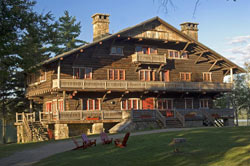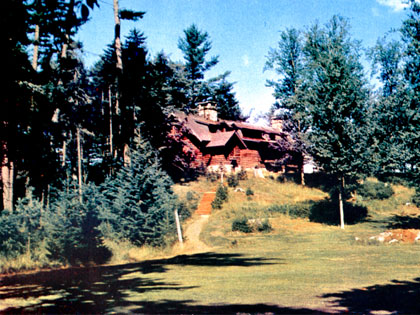What are the landmarks and topics to be visited and explored?
Forever Wild offers you the exciting opportunity to explore late 19th and early 20th century cultural ideals, social and economic issues, and political conflict surrounding the wilderness from the unique perspective of living within it. Beginning in Cortland, New York, a typical Gilded Age industrial city, you will become grounded in the social, economic and cultural dynamics of Gilded Age urban life while preparing to think about vital urban connections to the wilderness of the Adirondacks.
"The Huntington Camp/Pine Knot site was ideal. It enabled us to "live" the experience in the place(s) we were studying and it unified our group because we spent time together before, during, and after hours. It was incredible!" --2019 Summer Scholar
Cortland's Historic Downtown
 The 1890 House museum, listed on the National Register of Historic Places and located in the historic downtown district of Cortland, NY, functions as a museum and educational resource illustrating the domestic life of Cortland's industrial elite, the Wickwires.
The 1890 House museum, listed on the National Register of Historic Places and located in the historic downtown district of Cortland, NY, functions as a museum and educational resource illustrating the domestic life of Cortland's industrial elite, the Wickwires.
 Next door is the Lynne Parks ’68 SUNY Cortland Alumni House, another Wickwire family home. Together these buildings tell stories of Cortland's Industrial Age and Gilded past.
Next door is the Lynne Parks ’68 SUNY Cortland Alumni House, another Wickwire family home. Together these buildings tell stories of Cortland's Industrial Age and Gilded past.
Camp Huntington
 After our morning exploration of Cortland's Gilded Age industrial history, we will travel by chartered bus up to SUNY Cortland’s national treasure: Camp Huntington (originally called Camp Pine Knot), now a National Historic Landmark. Built by William West Durant in the 1870s, it is the first of the “Great Camps” in the Adirondacks. Camp Huntington is itself an inspirational instructional resource. While lodging at Camp Huntington, we will study documents, structures, and industrial processes while inhabiting spaces created by some of the most successful industrialists of the period. First-hand experiences at the camp will bring the era's ideas and debates to life and deepen our knowledge about the period. Learn more about Camp Huntington.
After our morning exploration of Cortland's Gilded Age industrial history, we will travel by chartered bus up to SUNY Cortland’s national treasure: Camp Huntington (originally called Camp Pine Knot), now a National Historic Landmark. Built by William West Durant in the 1870s, it is the first of the “Great Camps” in the Adirondacks. Camp Huntington is itself an inspirational instructional resource. While lodging at Camp Huntington, we will study documents, structures, and industrial processes while inhabiting spaces created by some of the most successful industrialists of the period. First-hand experiences at the camp will bring the era's ideas and debates to life and deepen our knowledge about the period. Learn more about Camp Huntington.
Camps Sagamore & Uncas

 We will also have the opportunity to visit Great Camps Sagamore and Uncas. These camps, also built and designed by Durant, are National Historic Landmark sites that catered to leisure and recreational interests of Gilded Age elite families. In 1901, Alfred Gwynne Vanderbilt, the great grandson of Cornelius " Commodore" Vanderbilt, purchased the Vanderbilt family retreat and named it Sagamore (for the native American term "sachem"). William West Durant had designed and built the property in 1897, experimenting with the design of what would become Great Camp architecture. The camp maintains 27 original buildings on nearly 10 acres, restored to their 1897 condition. J. P. Morgan owned Uncas, now privately owned, named after a character in James Fenimore Cooper’s novel The Last of the Mohicans. Uncas is architecturally significant as the first “compound plan” camp, designed and built as a single plan, rather than evolving over time as was the case at Pine Knot. Durant’s opulent, Swiss chalet-influenced architectural style, common to all three camps, is a reinterpretation of the rustic American log cabin. All three sites maintain original structures that illustrate the Adirondack architectural style, which influenced subsequent building designs as seen throughout the National Park Service.
We will also have the opportunity to visit Great Camps Sagamore and Uncas. These camps, also built and designed by Durant, are National Historic Landmark sites that catered to leisure and recreational interests of Gilded Age elite families. In 1901, Alfred Gwynne Vanderbilt, the great grandson of Cornelius " Commodore" Vanderbilt, purchased the Vanderbilt family retreat and named it Sagamore (for the native American term "sachem"). William West Durant had designed and built the property in 1897, experimenting with the design of what would become Great Camp architecture. The camp maintains 27 original buildings on nearly 10 acres, restored to their 1897 condition. J. P. Morgan owned Uncas, now privately owned, named after a character in James Fenimore Cooper’s novel The Last of the Mohicans. Uncas is architecturally significant as the first “compound plan” camp, designed and built as a single plan, rather than evolving over time as was the case at Pine Knot. Durant’s opulent, Swiss chalet-influenced architectural style, common to all three camps, is a reinterpretation of the rustic American log cabin. All three sites maintain original structures that illustrate the Adirondack architectural style, which influenced subsequent building designs as seen throughout the National Park Service.
Adirondack Experience
 In addition to the Great Camps themselves, we will engage in learning experiences with nearby partner, the Adirondack Experience, which houses artifacts representing the people, industries, and arts of the region. The museum’s industrial history collections illustrate the tension between the “wilderness ideal” of unspoiled nature and a late 19th century industrial economy as evidenced in the region’s economically important timber, rail, and mining industries. As the exhibits so clearly document, the Adirondack region was as much an industrial site as any Gilded Age city and faced the same economic, labor and class dilemmas as Pittsburgh, Cleveland, or Chicago.
In addition to the Great Camps themselves, we will engage in learning experiences with nearby partner, the Adirondack Experience, which houses artifacts representing the people, industries, and arts of the region. The museum’s industrial history collections illustrate the tension between the “wilderness ideal” of unspoiled nature and a late 19th century industrial economy as evidenced in the region’s economically important timber, rail, and mining industries. As the exhibits so clearly document, the Adirondack region was as much an industrial site as any Gilded Age city and faced the same economic, labor and class dilemmas as Pittsburgh, Cleveland, or Chicago.
